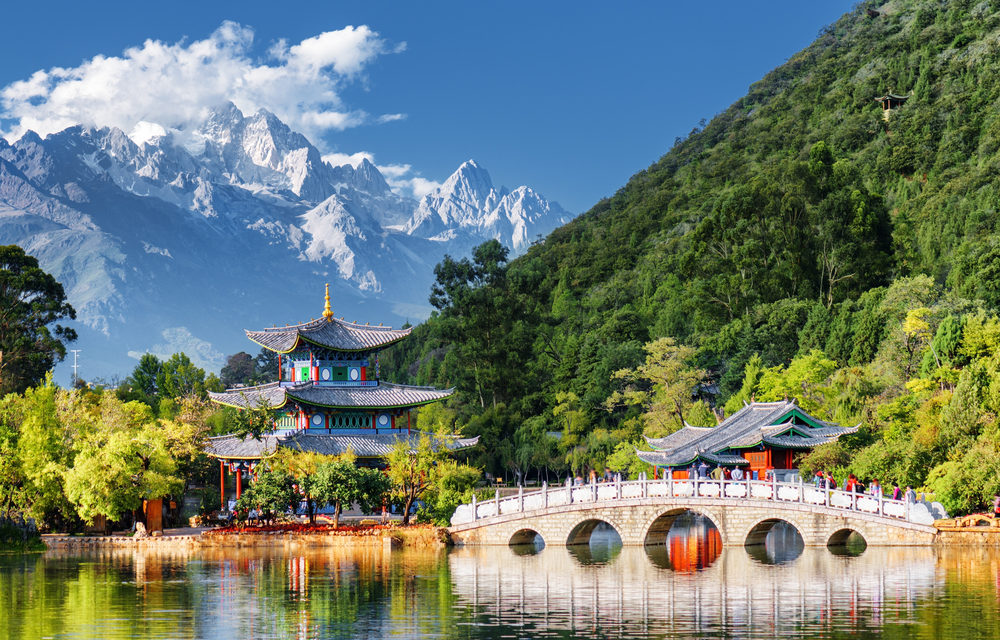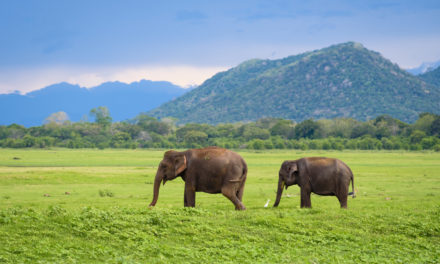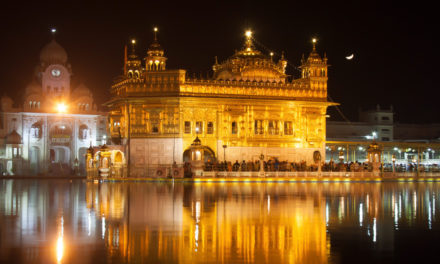Top Tourist Attractions And Things To Do In China
China is the cradle of one of the world’s oldest and most enduring cultures. China boasts some of the planet’s most extraordinary destinations, from the Terracotta Warriors and Forbidden City to the beloved giant pandas and the meandering Yangzi River.
While exploring bustling cities like Shanghai and Beijing, you can also glide past the limestone karsts of Yangshuo and visit serene monasteries in Emei Shan and Lhasa.
Given China’s immense size and the multitude of experiences it provides, travelers need to define their ideal Chinese journey. To make this task easier, we have created a list of top destinations and some of the best places to visit in China.
Tourist Travel Map of China

Best Places To Visit In China
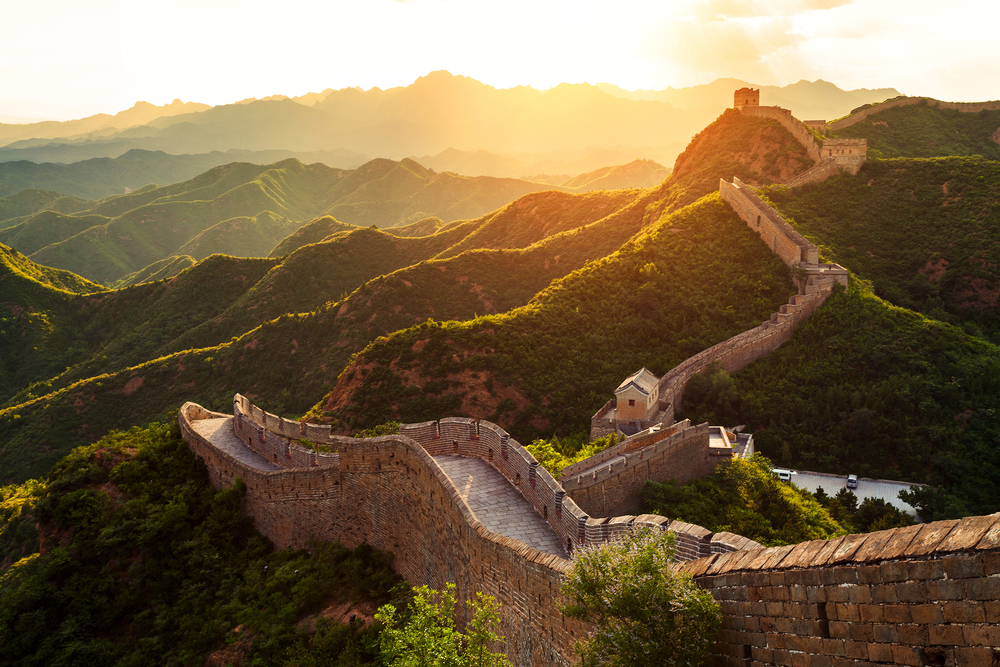
The Great Wall of China, Beijing:
The Great Wall of China stands as one of the most magnificent spectacles on Earth—a colossal, ancient defensive marvel and the longest wall ever constructed. As it meanders through challenging terrain, including rugged landscapes and towering mountains, it offers breathtaking vistas along its formidable route. Easily one of the most iconic landmarks in the world, this historic fortress should be on every traveler’s bucket list.
How to Reach The Great Wall of China:
Just an hour’s drive from Beijing, the most popular sections like Badaling and Mutianyu are easily accessible. Various tour options also make it a breeze to visit.
Number of Days to Visit The Great Wall of China:
A day trip is doable, but spending two days allows you to explore different sections and avoid the crowds.
Tourist Attractions and Things to Do in The Great Wall of China:
- Badaling Section: The most visited part, known for its panoramic views.
- Mutianyu Section: Less crowded and offers a more natural scenery.
- Jiankou: For adventure seekers, this unrestored section provides a challenging hike.
- Simatai: Famous for its night tours.
- Jinshanling: A perfect blend of restored and unrestored areas, great for photography.
For an unparalleled journey through time and a real-life history lesson, the Great Wall of China is an essential stop on any Chinese itinerary.
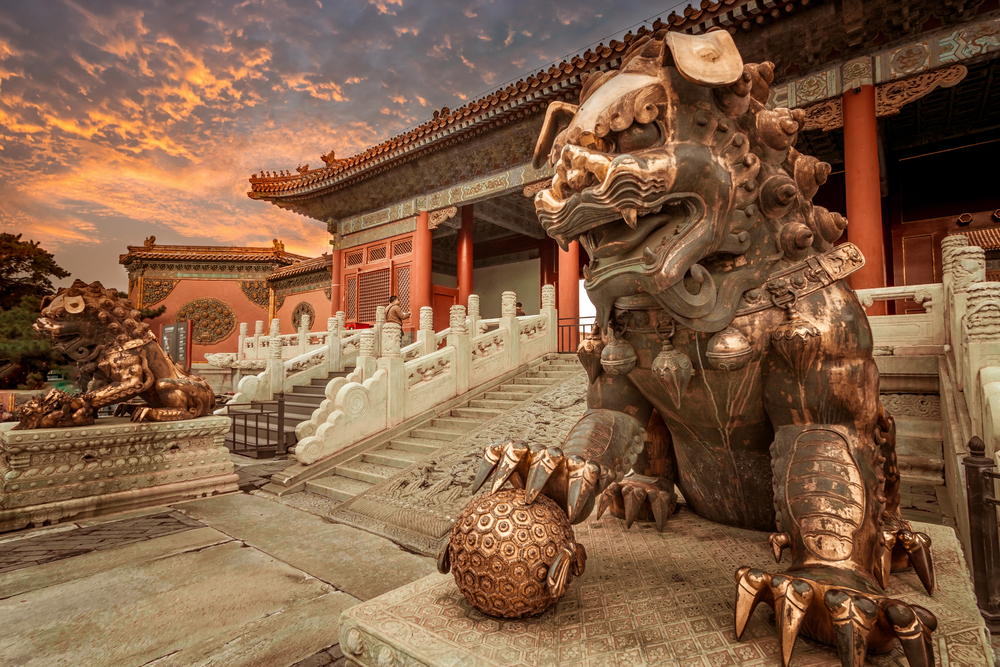
The Forbidden City, Beijing:
The Forbidden City, the ‘Former Palace’ in Chinese, served as the majestic epicenter of China. Situated in Beijing, this imperial palace complex belonged to both the Ming and Qing dynasties and once served as the seat of Chinese emperors for almost 500 years.
Ranked among the world’s top five palaces, it showcases the pinnacle of traditional Chinese architectural excellence in its grand halls and imposing walls. This architectural marvel is a fitting symbol for the capital of the world’s largest nation.
How to Reach The Forbidden City:
This iconic complex is situated at the heart of Beijing and is easily accessible via public transport or guided tours.
Number of Days to Visit The Forbidden City:
A full day is recommended to truly appreciate the vastness and details of this UNESCO World Heritage site.
Tourist Attractions and Things to Do in The Forbidden City:
- The Hall of Supreme Harmony: The grandest structure used for significant ceremonies.
- The Imperial Garden: A serene oasis amid grandiosity.
- The Palace Museum: A Palace with millions of rare and valuable works of art.
- Meridian Gate: The main entrance, with its iconic layout.
- The Nine Dragon Screen: A stunning, intricate ceramic screen that’s a photographer’s delight.
For those enchanted by the charisma of China’s imperial past, a day exploring the Forbidden City is time well spent.
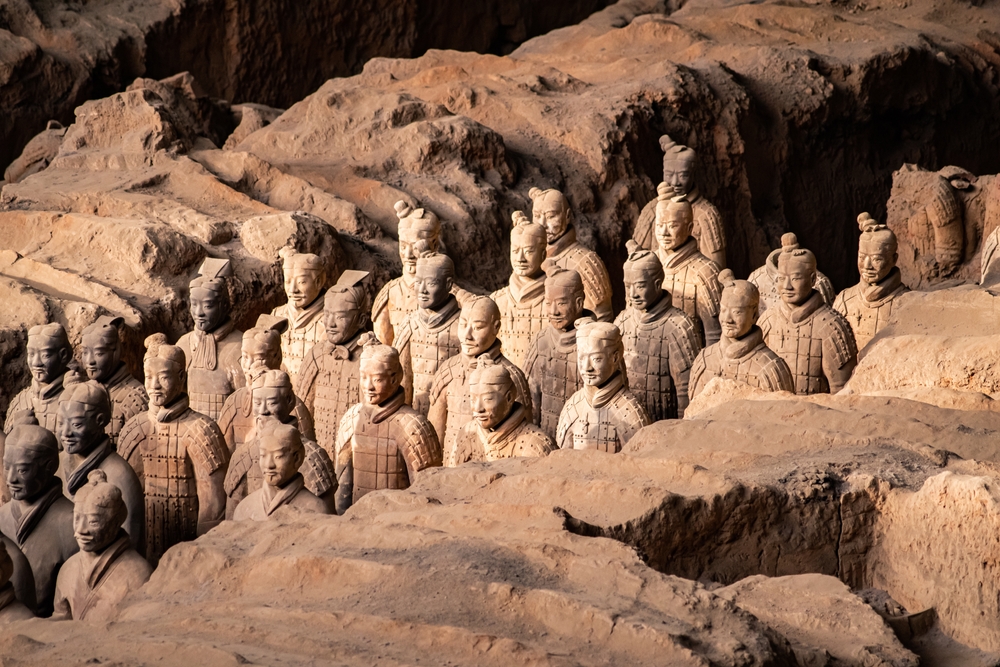
Terracotta Army, Xi’an:
Crafted to serve as guardians for China’s First Emperor in the afterlife, the Terracotta Army comprises thousands of meticulously detailed, life-sized soldier figurines representing the protective forces of Emperor Qin Shihuang. The soldiers were created with great attention to detail. They were made in different sections, fired, assembled, and decorated with bright and vibrant colors.
When in Xi’an, a visit to the Terracotta Army Museum is imperative. This site ranks among the most significant archaeological treasures globally, hailed as one of the foremost discoveries of the 20th century.
How to Reach the Terracotta Army in Xi’an:
Located just outside Xi’an, the Terracotta Army is a convenient day-trip destination from the city center.
Number of Days to Visit the Terracotta Army in Xi’an:
A day trip is sufficient to explore the multiple excavation pits and the accompanying museum.
Tourist Attractions and Things to Do in the Terracotta Army in Xi’an:
- Pit 1: The largest excavation pit housing most of the discovered figures.
- The Bronze Chariots: Exquisitely detailed models offering insights into ancient Chinese metallurgy.
- The Weapons: Remarkably well-preserved bronze swords, daggers, and other armaments.
- The Museum of Qin Terracotta Warriors and Horses: For a deeper understanding of the history and ongoing research.
- Photography Points: Certain spots offer unobstructed views for those must-have photos.
If you’re a history buff or fascinated by the grandeur of ancient civilizations, Xi’an’s Terracotta Army is an essential stop on your Chinese itinerary.
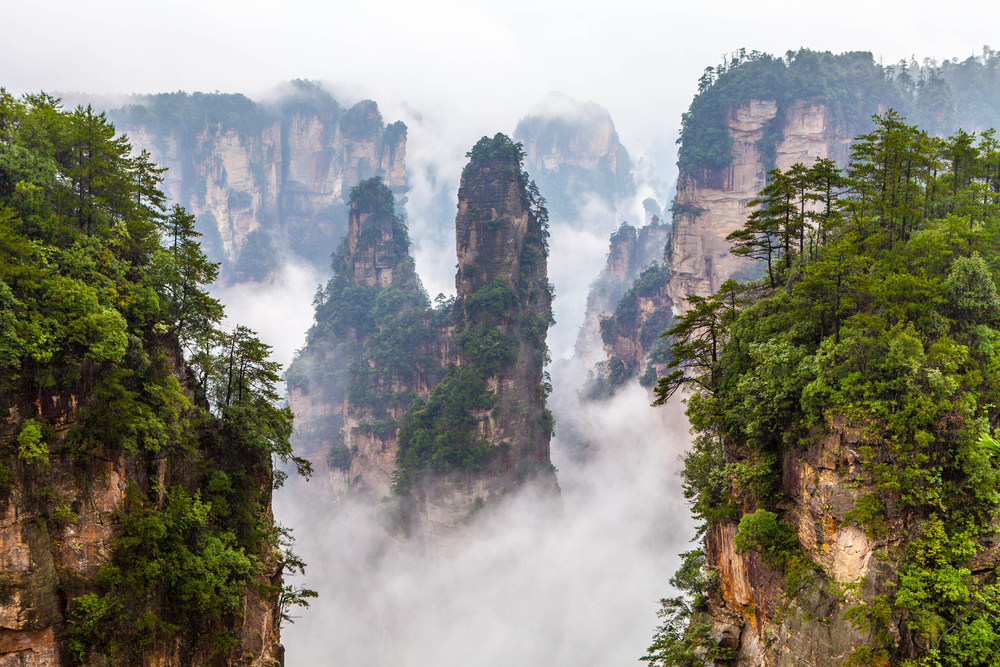
Zhangjiajie National Forest Park, Hunan:
Zhangjiajie National Forest Park inspired the floating mountains in James Cameron’s “Avatar.” Zhangjiajie National Forest Park is a surreal maze of towering sandstone pillars shrouded in mist and adorned with rich green foliage.
This ethereal landscape is a must-see for adventure seekers and nature enthusiasts alike. If you are in China, this is one of the best places to visit. The mountains are just incredible, and the world’s longest elevator has 326 floors.
How to Reach Zhangjiajie National Forest Park:
The park is located in Hunan Province, about a 4-hour drive from Changsha, Hunan’s capital. It’s a secluded paradise, far removed from China’s bustling cities.
Number of Days to Visit Zhangjiajie National Forest Park:
Allocate at least three days to explore the park’s various trails, viewpoints, and cable car rides.
Tourist Attractions and Things to Do in Zhangjiajie National Forest Park:
- Avatar Hallelujah Mountain: Yes, it’s named after the movie!
- Golden Whip Stream: A scenic area perfect for light hiking and photography.
- Tianzi Mountain: Offers panoramic views of the entire park.
- Bailong Elevator: The world’s tallest outdoor lift.
- Yuanjiajie: A scenic area known for its natural bridges and plateaus.
For a journey into one of the world’s most unique landscapes, Zhangjiajie should top your China travel bucket list.
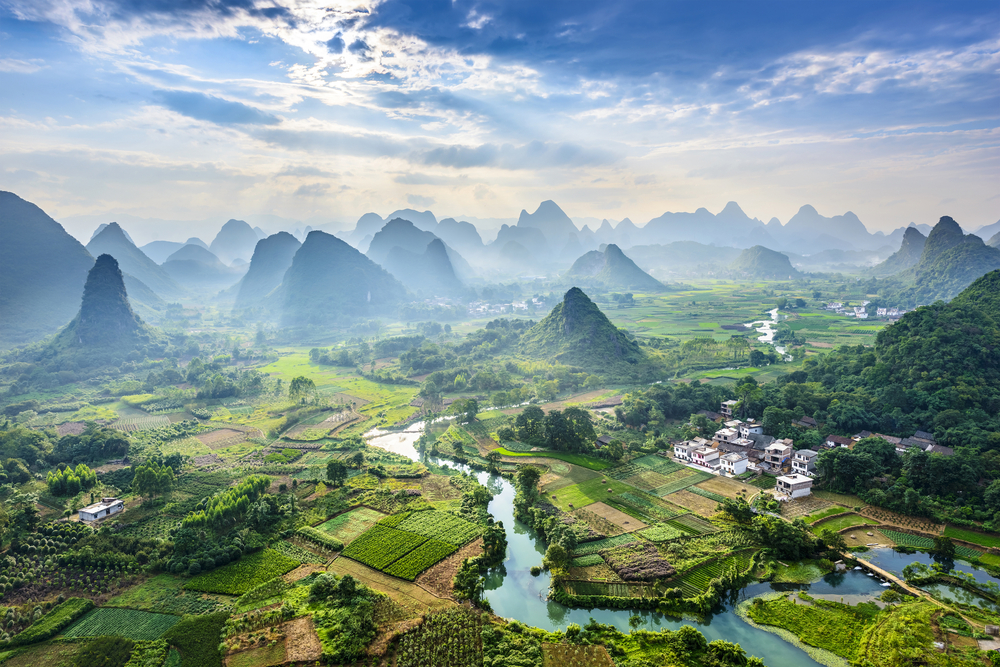
Li River and Karst Mountains, Guilin:
Found in Guangxi Province, the Li River is one of China’s most breathtaking locales. Stretching across approximately 80 kilometers, it weaves its way through the heart of Guangxi, linking the picturesque city of Guilin with the charming riverside town of Yangshuo.
An impressive multitude of karst mountains envelop the Li River and neighboring cities. These karst hills are among China’s most splendid natural marvels, formed over millions of years through water erosion and weathering.
The backdrop of the new 20 yuan banknote illustrates the scenery of this particular section.
How to Reach Li River in Guilin:
Guilin is situated in the Guangxi region, about a 2.5-hour flight from Beijing or Shanghai. The Li River stretches from Guilin to Yangshuo, providing the ideal setting for river cruises and hiking.
Number of Days to Visit Li River in Guilin:
For a comprehensive experience, plan on spending 3 to 4 days. This gives you enough time to enjoy a river cruise and explore the surrounding karst landscapes.
Tourist Attractions and Things to Do in Guilin:
- River Cruise: Sail through the Li River’s most scenic sections.
- Moon Hill: A natural arch offering panoramic views.
- Longji Rice Terraces: A must-visit for photographers.
- Elephant Trunk Hill: A hill resembling an elephant drinking water.
- Reed Flute Cave: A limestone cave featuring stunning stalactites and stalagmites.
Guilin’s Li River and Karst Mountains offer an idyllic retreat for a brush with ethereal natural beauty and an escape from the city’s hustle and bustle.
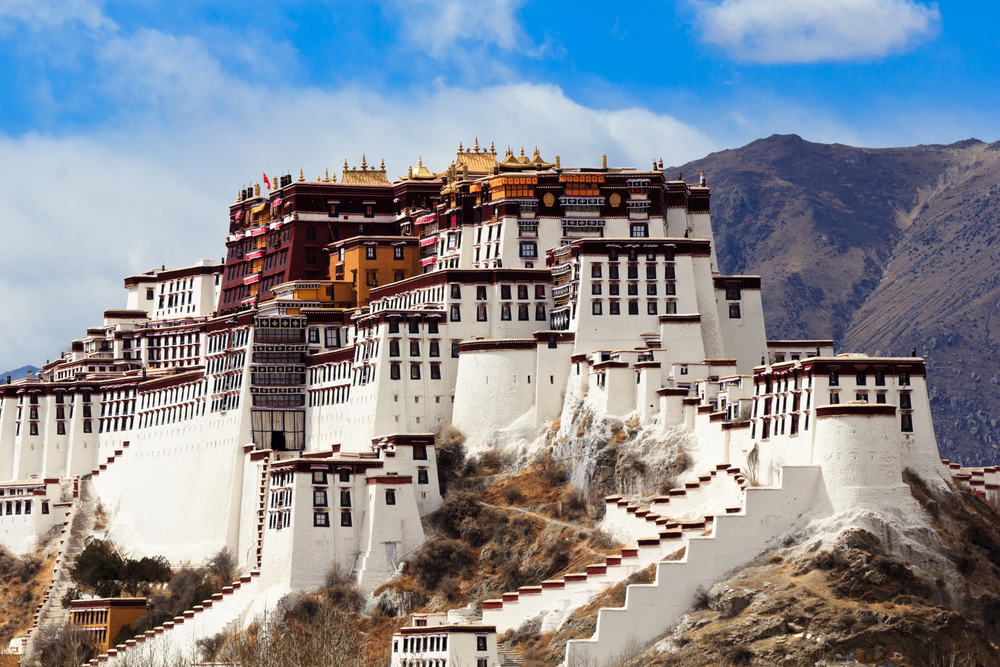
The Potala Palace, Tibet:
Potala Palace, a Tibetan architectural gem, has a rich history as the winter residence of the Dalai Lamas in Lhasa. It showcases Tibetan culture, art, and spirituality. The Dalai Lama’s home is a huge religious building and an amazing example of Tibetan architecture.
This palace is truly splendid and perfect for outdoor photography. You can sense the rich history here, where the Dalai Lama used to meet visitors, and the architecture is incredibly impressive.
How to Reach Potala Palace:
Situated in Lhasa, Tibet’s capital, the Potala Palace is accessible via various modes of transportation, including flights and trains.
Number of Days to Visit Potala Palace:
Allocate at least one full day to explore the palace grounds and surrounding areas.
Tourist Attractions and Things to Do in The Potala Palace, Tibet:
- White Palace: The winter residence of the Dalai Lama.
- Red Palace: A labyrinth of chapels and shrines.
- Jewel Gardens: A beautiful park filled with flora and fauna.
- Mural Paintings: Rich depictions of Buddhist lore.
- Dharma Cave: One of the oldest parts of the palace.
The Potala Palace is a historical monument and architectural gem that should be on your China bucket list.
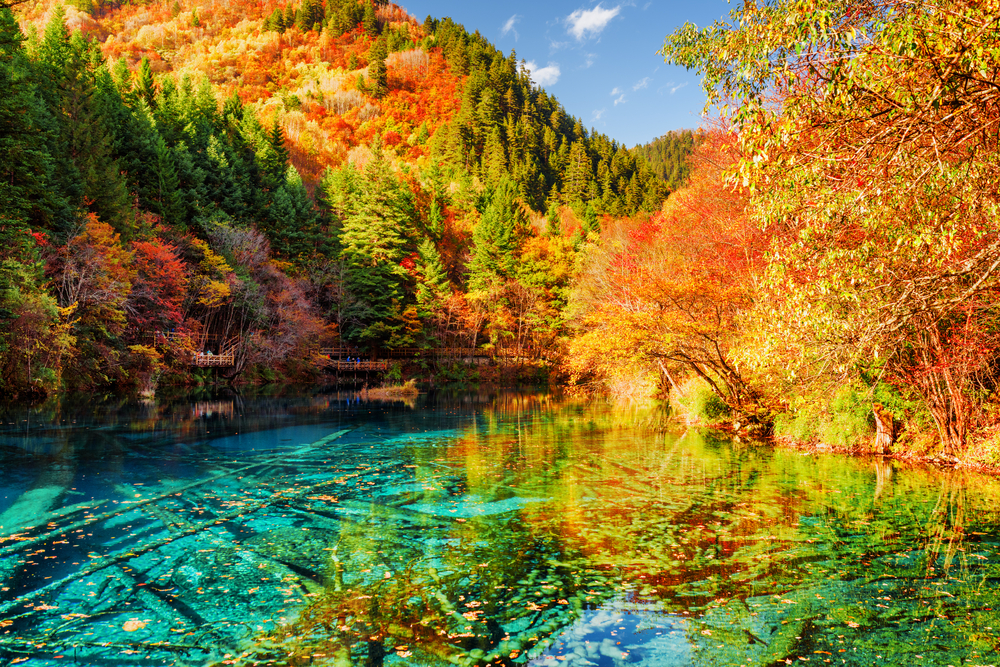
Jiuzhaigou Valley, Sichuan:
Jiuzhaigou Valley in Sichuan is a breathtaking tapestry of colorful lakes, snow-capped mountains, and verdant forests. If you’re searching for ethereal beauty, this UNESCO World Heritage site is your sanctuary.
Its stunning landscapes are captivating due to its tall, pointed rock formations and impressive waterfalls. In Jiuzhaigou, there are lakes with vibrant colors because they have a lot of a substance called calcium carbonate. The water is incredibly clear, and you can see the bottom, even in deep parts.
How to Reach Jiuzhaigou Valley :
Nestled in the Min Mountains of Sichuan Province, Jiuzhaigou Valley is about an 8-hour drive or a quick flight from Chengdu.
Number of Days to Visit Jiuzhaigou Valley:
At least three days are needed to fully explore this natural wonder’s scenic spots and hiking trails.
Tourist Attractions and Things to Do in Jiuzhaigou Valley:
- Five-Color Pond: One of the area’s smallest but most vibrant lakes.
- Nuorilang Waterfalls: Standing tall at 20 meters, it’s one of China’s widest waterfalls.
- Long Lake: Jiuzhaigou’s deepest and largest lake, set against mountains.
- Shuzheng Village: Experience Tibetan culture up close.
- Mirror Lake: Known for its crystal-clear reflections.
Jiuzhaigou Valley is an unmissable stop on your China adventure if you want to immerse yourself in a landscape that feels like a living painting.
Ready to Explore Top Destinations in Asia?
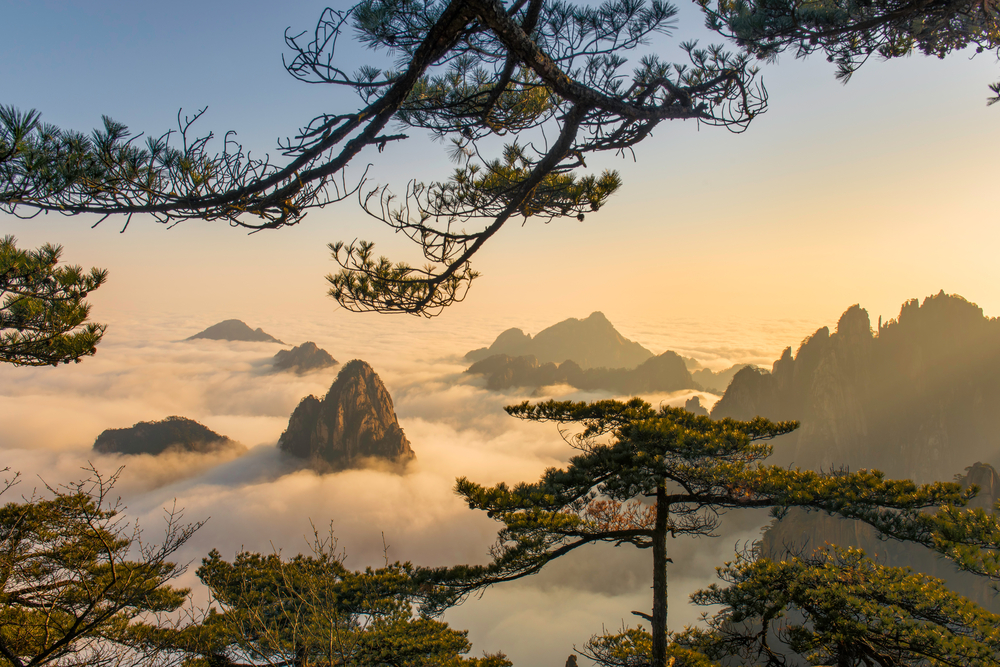
Yellow Mountains (Huangshan), Anhui:
Huangshan, also known as the Yellow Mountains, located in China’s Anhui province, is an outstanding spot for those seeking China’s natural wonders. A UNESCO World Heritage site, Huangshan offers mist-shrouded peaks, ancient pine trees, and unique rock formations that have inspired Chinese poets and painters for centuries.
It’s famous for stunning landscapes, unique rock formations, ethereal clouds, hot springs, and charming rural villages. The Yellow Mountains are truly magnificent and a top destination in China.
How to Reach Yellow Mountains, Anhui:
In southern Anhui Province, Huangshan is about a 4-hour drive from Shanghai.
Number of Days to Visit Yellow Mountains, Anhui:
Plan a 2-3 day visit to conquer the mountain trails and catch sunrise and sunset views.
Tourist Attractions and Things to Do in Yellow Mountains, Anhui:
- Begin to Believe Peak: Perfect for catching the sunrise.
- West Sea Grand Canyon: A visual feast of craggy peaks.
- Cloud-Dispelling Pavilion: Aptly named for its cloud-penetrating views.
- Celestial Capital Peak: For the adrenaline junkies, this peak offers challenging ascents.
- Hot Springs: Relax your muscles after a day of hiking.
If ethereal scenery and hiking excursions speak to your soul, the Yellow Mountains offer an adventure you’ll never forget.
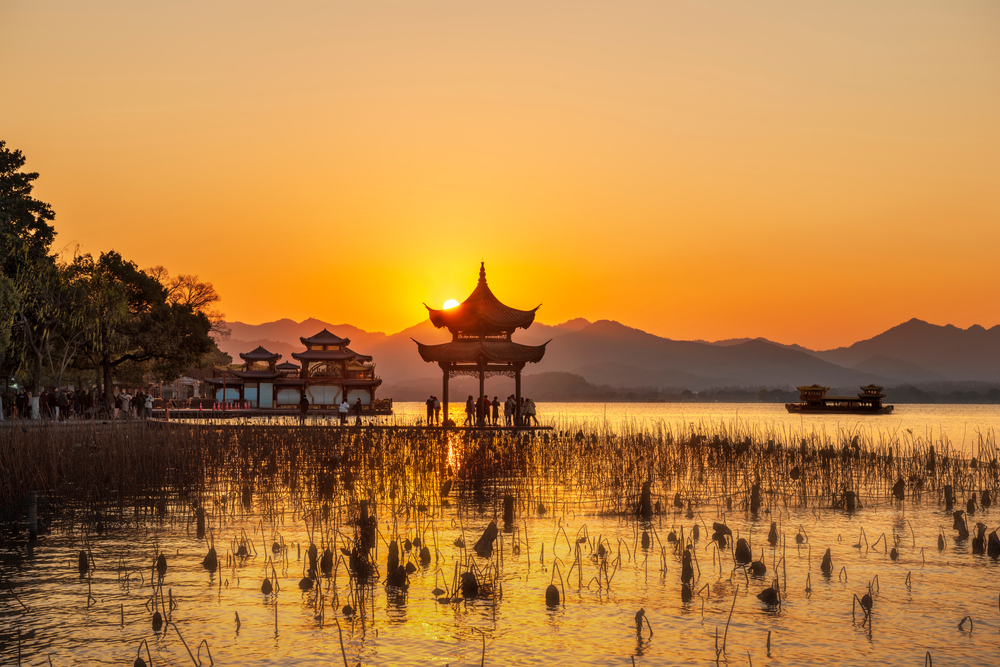
West Lake, Hangzhou:
Hangzhou’s West Lake epitomizes classical beauty in China, where water and sky blur and pagodas punctuate a horizon framed by jade-green hills. This tranquil retreat has been the muse for poets and painters, providing a scenic sanctuary amidst modern China.
Surrounding the lake, pathways, well-placed benches, parks, and gardens provide numerous spots for visitors to savor the flawless scenery.
How to Reach Hangzhou’s West Lake:
Hangzhou’s West Lake is a 45-minute high-speed train ride from Shanghai.
Number of Days to Visit Hangzhou’s West Lake:
Allocate at least a day to revel in the lake’s tranquility, but a 2-day stay lets you explore the surrounding tea plantations as well.
Tourist Attractions and Things to Do in Hangzhou’s West Lake:
- Leifeng Pagoda: A must-visit for panoramic lake views.
- Broken Bridge: Known for its romantic folklore.
- Three Ponds Mirroring the Moon: Best viewed during the full moon.
- Xixi Wetland: A break from the urban hustle.
- Lingyin Temple: One of China’s oldest Buddhist temples.
When you need a breather from China’s fast-paced cities, West Lake is an oasis of calm and natural splendor.
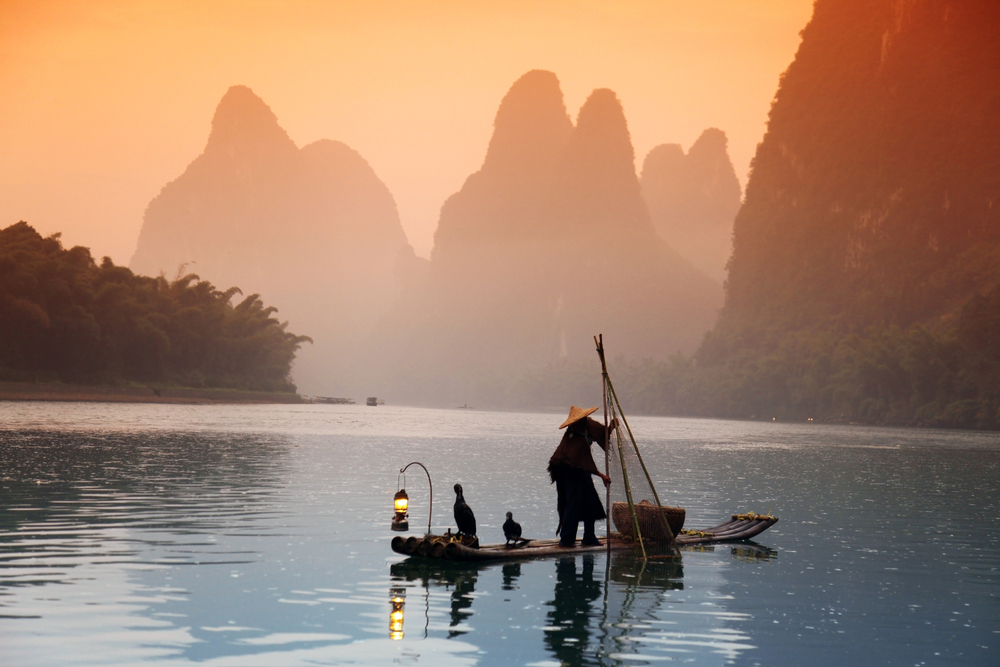
Yangshuo Countryside, Guangxi:
Yangshuo is renowned for its picturesque rural landscapes showcasing traditional farm life, with water buffalo plowing fields and hand-harvested rice paddies. The Yulong River meanders alongside Karst mountains, offering punting trips with local farmers.
Yangshuo’s countryside is famous for its stunning scenery and popular spot for outdoor enthusiasts. Rock climbing enthusiasts worldwide are drawn to the unique Karst rock formations, making it a rock climbing paradise in China.
You can explore Yangshuo’s countryside on land or through waterways to suit your preferences. With winding rivers and emerald hills, it’s a world away from China’s bustling cities.
How to Reach Yangshuo’s countryside:
Yangshuo is about a 1.5-hour drive from Guilin, which is well-connected by air and train to major Chinese cities.
Number of Days to Visit in Yangshuo’s countryside:
Plan for at least three days to fully appreciate Yangshuo’s diverse landscapes.
Tourist Attractions and Things to Do in Yangshuo’s countryside:
- Li River Cruise: A scenic boat ride amidst stunning karst formations.
- Moon Hill: Ideal for hiking and unparalleled vistas.
- Impression Sanjie Liu: A nighttime light show on the river.
- Bamboo Rafting: For a slower-paced view of the landscape.
- Cormorant Fishing: Witness this traditional fishing technique on the Li River.
Yangshuo offers a serene yet adventurous break, with its outdoor activities and laid-back rural life proving that China is more than just its mega-cities.

Chengdu Research Base of Giant Panda Breeding, Chengdu:
Cue the collective “aww” as you meet China’s cuddliest icons at the Chengdu Panda Base. A haven for panda conservation, it’s a must-visit for any animal lover.
In addition to being a research and breeding center for giant pandas, the Chengdu Panda Base is also home to the adorable and lesser-known red pandas. These charming creatures share the panda base and are equally captivating to visitors.
How to reach Chengdu Research Base:
The base is situated just 10 km away from downtown Chengdu, easily reachable by taxi or bus.
Number of Days to Visit Chengdu Panda Base:
Half a day should suffice to see these adorable creatures and learn about ongoing conservation efforts.
Tourist Attractions and Things to Do in Chengdu Panda Base:
- Panda Enclosures: Observe pandas in settings that mimic their natural habitat.
- Panda Nursery: Witness baby pandas and maybe catch feeding time.
- Panda Museum: Educates visitors on the history and struggles of the giant panda.
- Red Pandas: They’re not just about giant pandas; meet their smaller, equally cute cousins.
- Souvenir Shops: Take home a cuddly panda plushie as a souvenir.
With a mission to educate and conserve, the Chengdu Panda Base lets you walk away with more than just cute photos—it instills a greater appreciation for wildlife conservation.
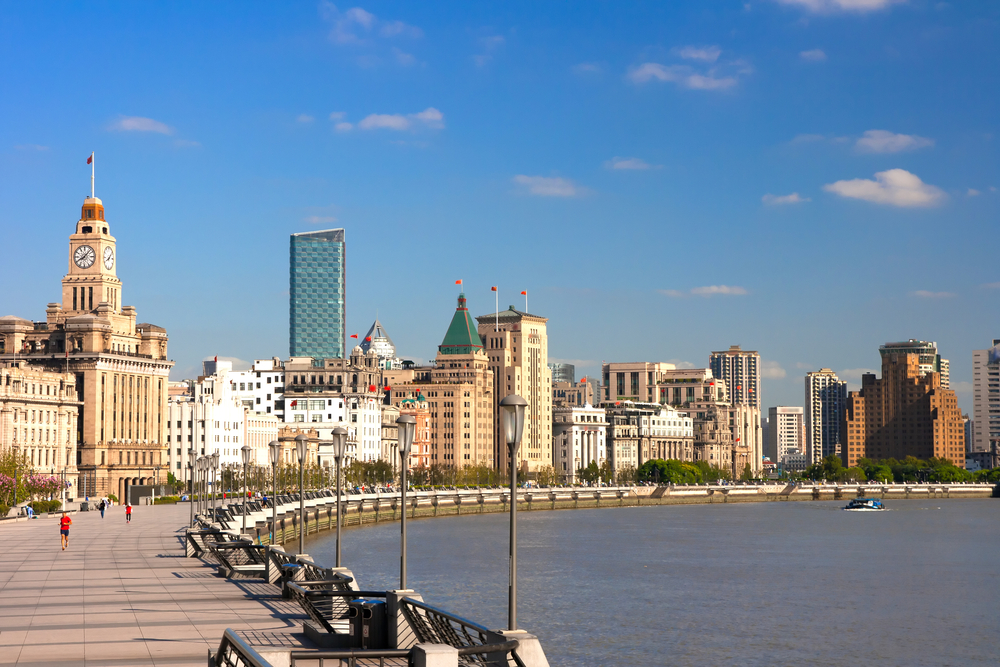
The Bund, Shanghai:
The Bund in Shanghai, known for its iconic skyline, was a muddy waterfront area in the 19th century. Only after the British established their concession the area was transformed into a thriving financial district, leading to the impressive architecture we see today.
Stroll along The Bund, Shanghai’s iconic waterfront, and you’ll witness a stunning juxtaposition of historic architecture and modern skyscrapers.
How to Reach The Bund in Shanghai:
It is located in central Shanghai, along the western bank of the Huangpu River.
How Much Time to Visit The Bund in Shanghai:
You can easily explore The Bund in a few hours, but you can return at different times of the day to capture its changing moods.
Tourist Attractions and Things to Do in The Bund, Shanghai:
- Skyline Views: Unbeatable vistas of Shanghai’s futuristic skyline.
- Historic Buildings: More than 50 colonial-era structures with diverse architectural styles.
- River Cruises: Opt for a boat ride for a different cityscape perspective.
- Monuments: Don’t miss the Monument to the People’s Heroes.
- Shopping and Dining: Upscale boutiques and fine dining options abound.
Whether it’s the early morning calm or the electric atmosphere at night, The Bund offers a snapshot of Shanghai’s vibrant pulse.
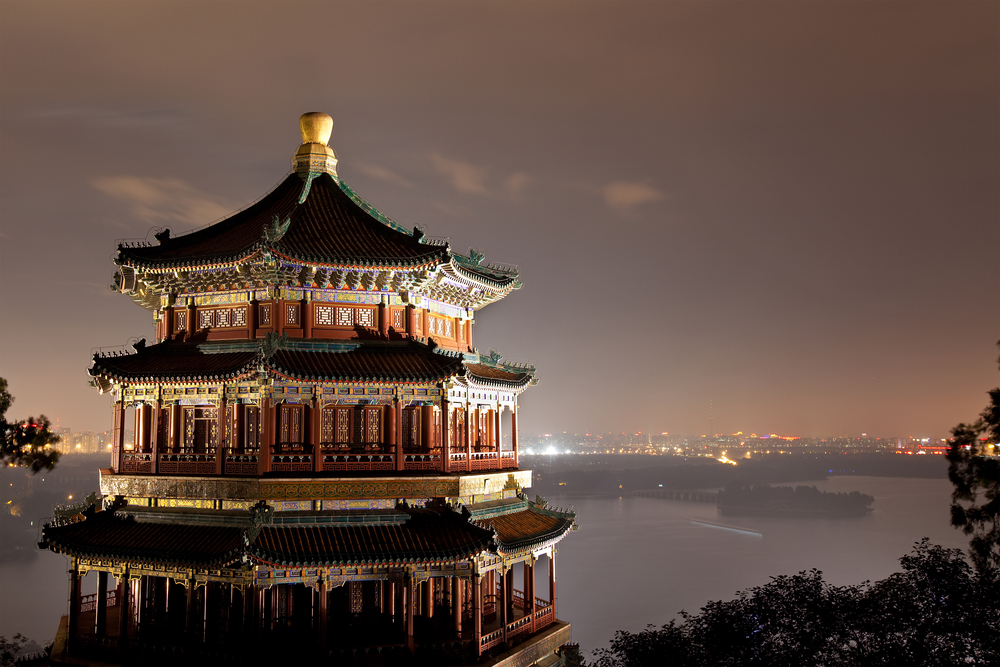
Summer Palace, Beijing:
Nestled in the heart of Beijing, the Summer Palace stands as a captivating testament to Chinese imperial grandeur and natural beauty.
The Summer Palace in Beijing features a man-made lake, Kunming Lake, covering about 2.2 square kilometers (0.8 square miles). What’s fascinating is that this vast lake was created by excavating soil to construct the palace complex, making it one of the world’s largest imperial gardens with an artificial lake.
How to Reach Summer Palace in Beijing:
It is nestled in the Haidian District, about 15 kilometers northwest of central Beijing.
How Much Time to Visit Summer Palace in Beijing:
To completely appreciate the detailed architecture and vast landscapes, one should spend a full day exploring.
Tourist Attractions and Things to Do in Summer Palace, Beijing:
- Kunming Lake: A massive, man-made lake ideal for boat rides.
- Longevity Hill: Offers panoramic views of the palace and beyond.
- Suzhou Street: A bustling market street replicating the famous Suzhou city.
- Hall of Benevolence and Longevity: The primary building where emperors held court.
- Marble Boat: An iconic, immovable structure at the edge of Kunming Lake.
As you explore these captivating sights, you’ll feel like you’ve stepped into a Chinese scroll painting. It’s easy to see why the Summer Palace is often considered the pinnacle of Chinese classical gardens.

Silk Road, Xi’an to Urumqi:
The Silk Road constituted a vast network of trade pathways that linked China and the Far East to the Middle East and Europe. Stretching from Xi’an to Urumqi, the iconic route is a living museum of ancient China.
Along this historic route, you can savor diverse dishes influenced by the many cultures traded here, from aromatic spices in the west to delectable dumplings in the east. These interconnected routes facilitated trade and fostered the exchange of cultures and ideas across continents, leaving an enduring legacy in history.
How to Reach The Silk Road in China:
Beginning in Xi’an and culminating in Urumqi, the route spans multiple provinces across northern China.
Number of Days to Visit The Silk Road in China:
At least 10-14 days are advisable to delve into the historical and cultural significance of the Silk Road.
Tourist Attractions and Things to Do in The Silk Road, China:
- Mogao Caves: An awe-inspiring collection of Buddhist art and scriptures.
- Turpan Depression: The world’s second-lowest depression, filled with unique flora and fauna.
- Jiaohe Ruins: An ancient city that takes you back in time.
- Heavenly Lake: A serene, alpine lake surrounded by snow-capped peaks.
- The Flaming Mountains: Get spellbound by these red sandstone hills, especially captivating at sunset.
The Silk Road offers a spiritual journey that unearths China’s multi-layered history. Traveling along this route, you’ll connect the dots between civilizations, traditions, and landscapes that have shaped the world as we know it today.
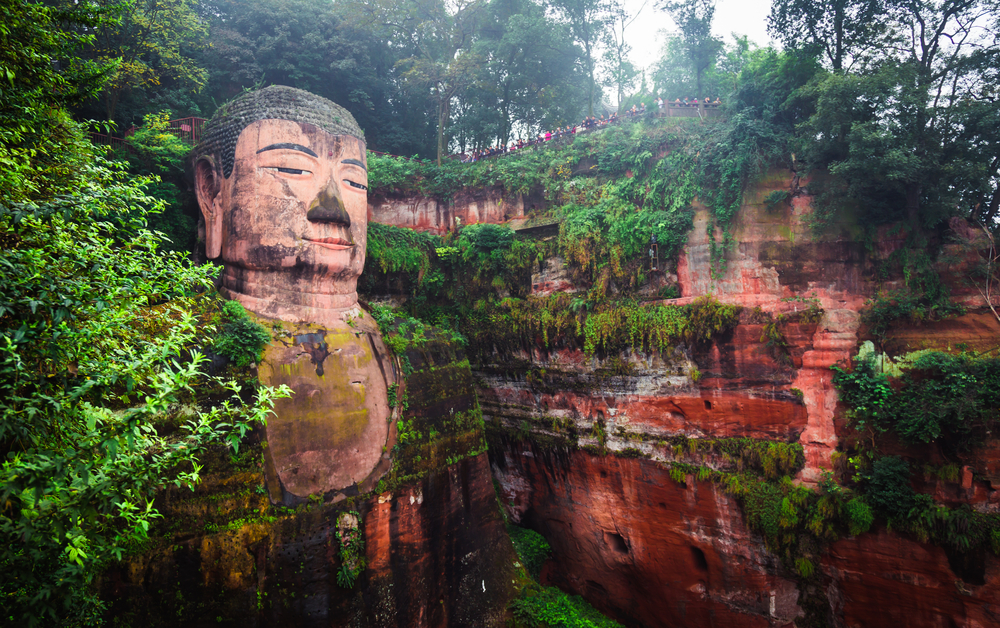
Leshan Giant Buddha, Sichuan:
The Leshan Giant Buddha in Sichuan, China, is an awe-inspiring colossal statue and a remarkable feat of ancient engineering. Carved directly into a cliff, it’s the largest stone Buddha statue in the world, standing at an astonishing 71 meters (233 feet) tall.
You have to navigate the waters of the Min River in Sichuan to stand before the grand Leshan Giant Buddha, a monolithic statue that has stood the test of time. This iconic and serene figure continues to captivate visitors with its grandeur and historical significance, making it a must-see attraction in China.
How to Reach The Leshan Giant Buddha:
The Leshan Giant Buddha is located in Leshan City, Sichuan Province, about a 2-hour drive from Chengdu.
Number of Days to Visit The Leshan Giant Buddha:
One day is usually sufficient to visit the site and marvel at its artistic and historical grandeur.
Tourist Attractions and Things to Do in The Leshan Giant Buddha:
- The Buddha’s Toes: Yes, they’re so large you can stand on them!
- Mt. Emei Scenic Area: Located nearby, it’s another UNESCO World Heritage site worth exploring.
- Lingyun Temple: A historic temple that offers insights into China’s Buddhist culture.
- Boat Tour: The best way to get a full view of the gigantic statue.
- Local Cuisine: Try delicious Sichuan dishes in the surrounding area.
Behold the grandeur of the Leshan Giant Buddha, carved into a cliff facing the convergence of three rivers. It’s a sight that invites reflection and awe, making you ponder the capability and vision of ancient craftsmanship.
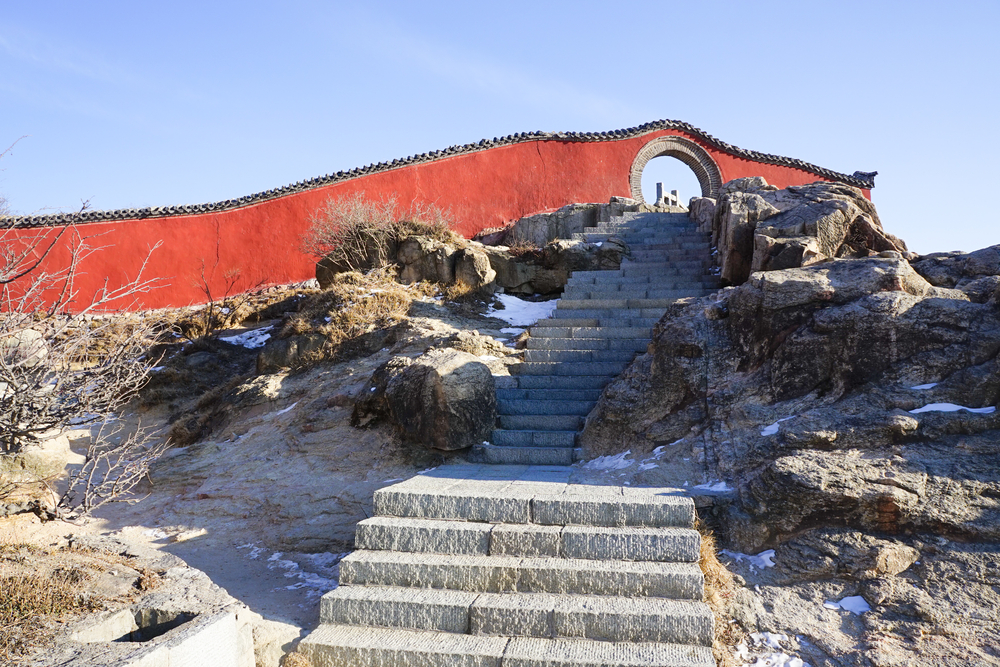
Mount Tai, Shandong:
Mount Tai is a sacred site with a rich history, one of the Five Great Mountains of China, rich in natural beauty and cultural significance. It’s often called the “First Among the Five Sacred Mountains of China” and has been a place of worship for over 3,000 years, attracting emperors, scholars, and pilgrims throughout Chinese history.
Mount Tai’s blend of natural beauty and cultural significance makes it a revered destination where history and spirituality converge, inviting travelers to explore its heights and heritage.
How to Reach Mount Tai:
Mount Tai is in the Shandong Province and is easily accessible from cities like Jinan and Qufu.
Number of Days to Visit Mount Tai in China:
Plan a 2-3 day trip for a thorough exploration, giving you time to hike and absorb the mountain’s sanctity.
Tourist Attractions and Things to Do in Mount Tai in China:
- Sunrise Viewpoint: An unforgettable experience to see the day break over China.
- Dai Temple: The main temple dedicated to the god of Mount Tai.
- Eighteen Bends: A steep, zigzagging path that’s a challenging but rewarding trek.
- Inscriptions and Stone Tablets: Mount Tai is home to numerous ancient inscriptions and carvings.
- Heavenly Street: A commercial area for souvenirs and local snacks.
Mount Tai offers a captivating blend of the spiritual and the scenic. It is one of the most popular destinations in China.
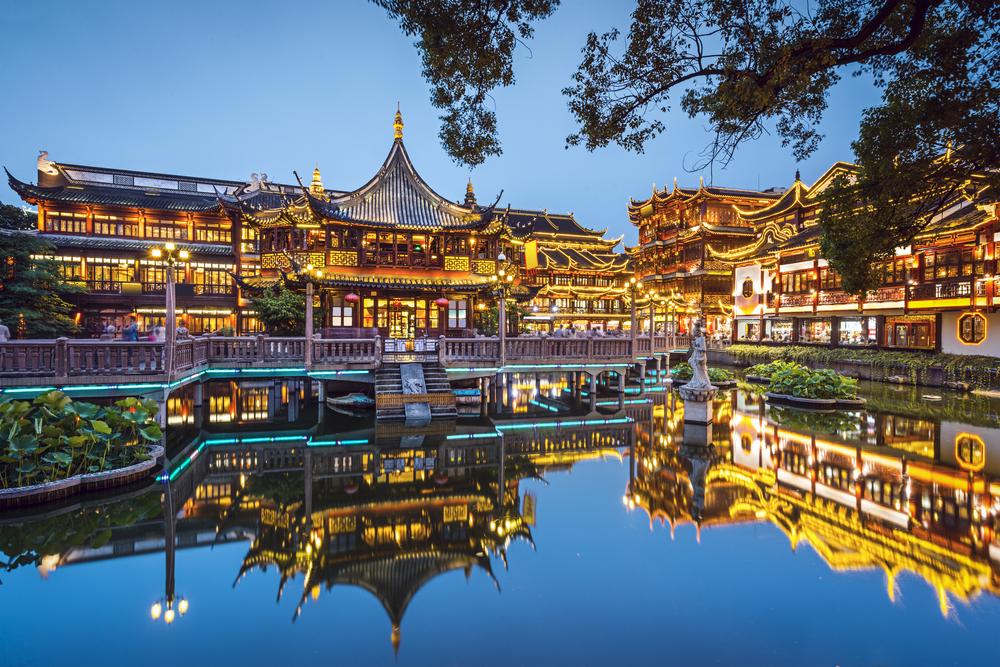
Yu Garden, Shanghai:
Yu Garden in Shanghai, also known as the Garden of Happiness, features a unique design element where the number 9 is predominant. It’s believed to bring good luck, and you’ll notice this number repeated throughout the garden in the form of nine zigzag bridges, nine dragonheads on the walls, and other architectural features.
Known as a sanctuary amidst urban chaos, Yu Garden in Shanghai epitomizes classical Chinese design.
How to Reach Yu Garden in Shanghai:
In the heart of Shanghai’s Old City, Yu Garden is easily accessible by metro or taxi.
How Much Time to Visit Yu Garden in Shanghai:
Half a day is enough to explore the garden’s intricate layouts and stunning vistas.
Tourist Attractions and Things to Do in Yu Garden, Shanghai:
- Dragon Wall: This iconic feature divides garden sections and is beautifully adorned with dragon motifs.
- Koi Pond: A peaceful body of water teeming with koi fish—ideal for a few moments of reflection.
- The Jade Rock: A five-ton porous rose-colored boulder, considered one of southern China’s three most famous rocks.
- Heralding Spring Hall: A classic teahouse, perfect for a relaxing tea break.
- Exquisite Jade Tower: An impressive building adorned with intricate carvings and designs.
Yu Garden offers a glimpse into traditional Chinese artistry and architecture while temporarily escaping Shanghai’s busy pace. With winding paths, lush foliage, and iconic structures, this is a must-visit locale for any traveler searching for peace and culture.
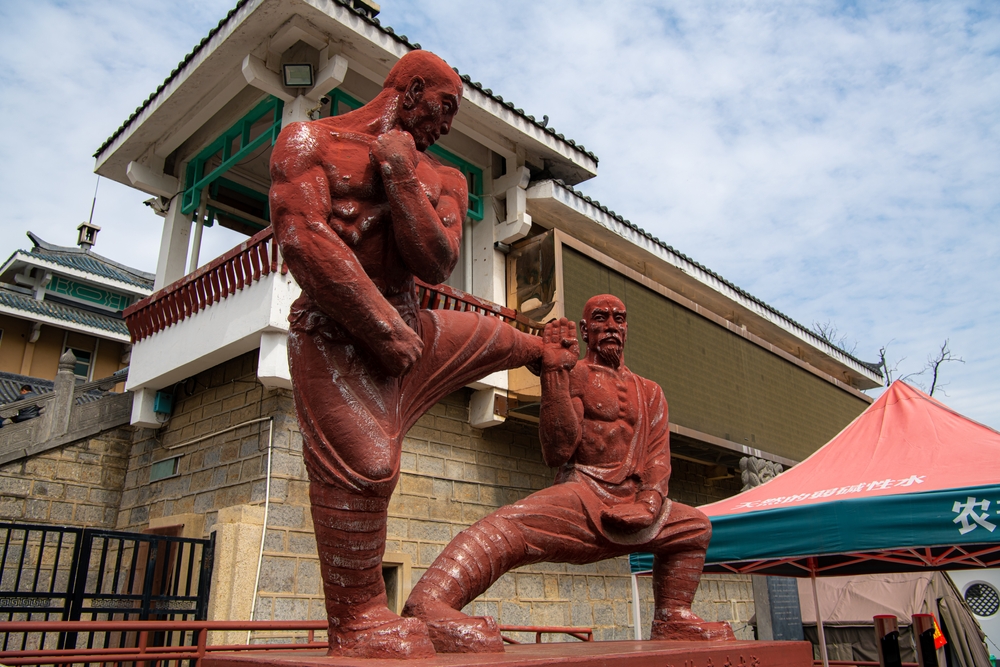
Shaolin Temple, Henan:
The birthplace of kung fu, the Shaolin Temple in Henan, is a living testament to the profound impact of martial arts on Chinese culture.
The Shaolin Temple in Henan is a renowned center for martial arts and a place with a surprising natural phenomenon. Within the temple complex, a unique evergreen pine tree defies the seasons by remaining green throughout the year, even in the dead of winter when the surrounding trees shed their leaves. It’s known as the “Green Pine in the Shaolin Temple,” symbolizing endurance and resilience.
How to Reach Shaolin Temple in Henan:
Situated in the forests of the Song Mountains, the Shaolin Temple is about a two-hour drive from Zhengzhou, the capital of Henan Province.
Number of Days to Visit Shaolin Temple in Henan:
One full day should suffice to explore the temple complex and catch a kung fu demonstration.
Tourist Attractions and Things to Do in Shaolin Temple, Henan:
- Pagoda Forest: A collection of stupas honoring eminent monks through the ages.
- Dharma Cave: A serene spot where the founder of Zen Buddhism, Bodhidharma, meditated.
- Kung Fu Demonstrations: Take advantage of the jaw-dropping martial arts displays by the temple’s monks.
- Hall of Heavenly Kings: An important structure with stunning statues of the Four Heavenly Kings.
- Shaolin Pharmacy Bureau: Explore traditional Chinese medicine’s roots and even purchase herbal remedies.
The Shaolin Temple isn’t just for martial arts enthusiasts. Its rich history, stunning natural setting, and iconic cultural relevance make it a bucket-list destination for any curious traveler in China.
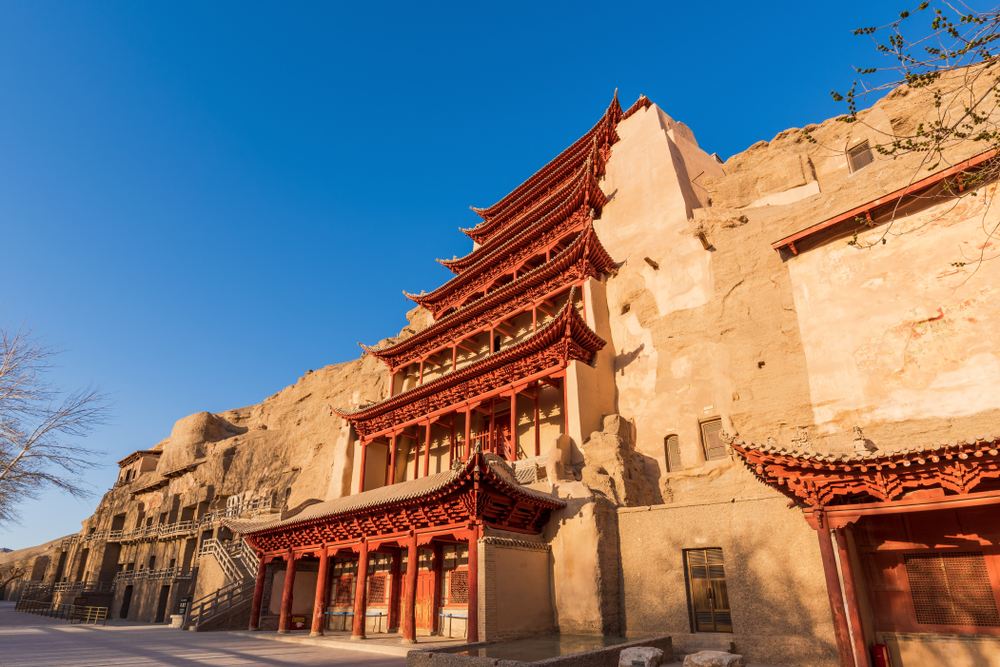
Mogao Caves, Dunhuang:
The Mogao Caves in Dunhuang, commonly known as the “Caves of a Thousand Buddhas,” constitute an ancient sanctuary of Buddhist art. It offers a captivating visual journey through China’s rich spiritual and cultural history.
In 1900, a caretaker stumbled upon a hidden chamber filled with thousands of well-preserved ancient manuscripts, paintings, and artifacts, some dating back over a thousand years. This discovery shed new light on the history and culture of the Silk Road and became a significant archaeological find of the 20th century.
How to Reach Magao Caves in Dunhuang:
Nestled in the Gobi Desert, the Mogao Caves are located 25 km southeast of Dunhuang city center.
Number of Days to Visit Magao Caves in Dunhuang:
A 1-2 day visit is ideal to delve into the intricate frescoes and sculptures.
Tourist Attractions and Things to Do in Magao Caves, Dunhuang:
- Library Cave: Home to the world’s oldest collection of Chinese Buddhist manuscripts.
- Giant Buddha Cave: Houses a 26-meter-high Buddha statue.
- Cave 428: Famous for its 10th-century mural depicting the Buddha’s enlightenment.
- Cave 96: Showcases a 35.5-meter-high Maitreya Buddha.
- Nine-Story Building: A museum that elaborates on the caves’ history and significance.
Visiting the Mogao Caves is like stepping into a time capsule of art and spirituality, making it a remarkable destination for history and culture enthusiasts.
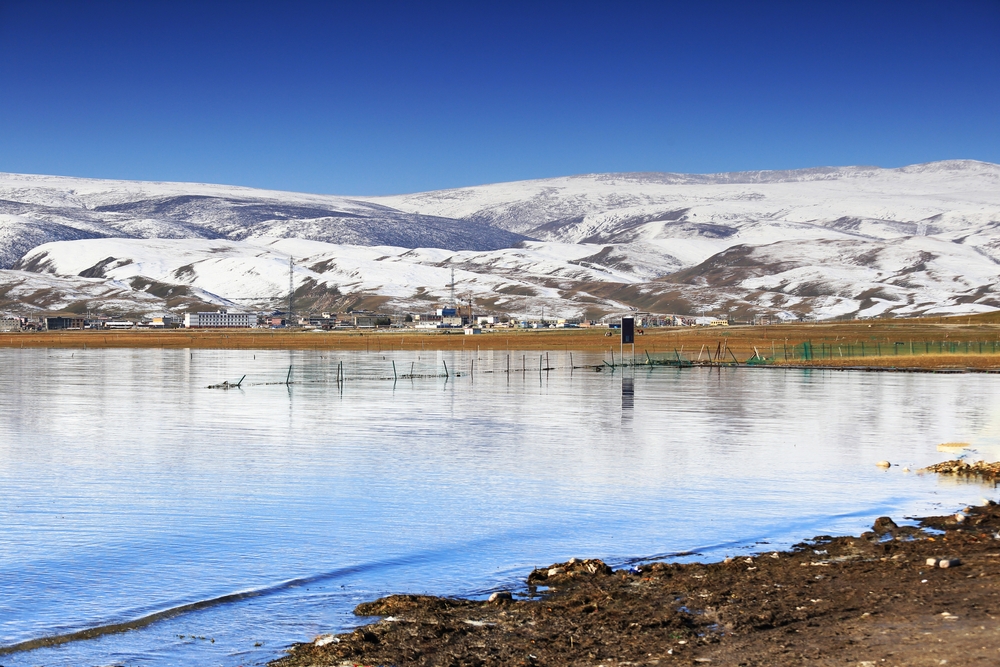
Qinghai Lake, Qinghai:
Qinghai Lake, located in the Qinghai-Tibet Plateau, is China’s largest inland saltwater lake and a vital stopover point for migratory birds along the East Asian-Australasian Flyway. Thousands of birds from Siberia and Central Asia visit the lake’s shores every year, making it a significant spot for birdwatching and conservation efforts.
Known as “Koko Nor” in Mongolian, this natural marvel is a serene escape that speaks to the soul of every nature enthusiast.
How to Reach Qinghai Lake in China:
Situated in China’s Qinghai province, the lake is about 100 km from Xining, the provincial capital.
Number of Days to Visit Qinghai Lake in China:
Plan a 1-2 day getaway to immerse yourself in the scenic landscapes and natural beauty fully.
Tourist Attractions and Things to Do in Qinghai Lake, China:
- Bird Island: A paradise for bird watchers, especially during the annual migration season.
- Erlangjian Scenic Area: Offers the best lake views and photography spots.
- Riyue Mountain: Ideal for hiking and witnessing the sunrise or sunset.
- Qinghai Lake Cycling Race: A global event that should not be missed if you’re there during the season.
- Tibetan Villages: Get a glimpse of Tibetan culture and lifestyle.
Qinghai Lake is an oasis of tranquility and beauty, making it a must-visit destination for those looking to disconnect and reconnect with nature.
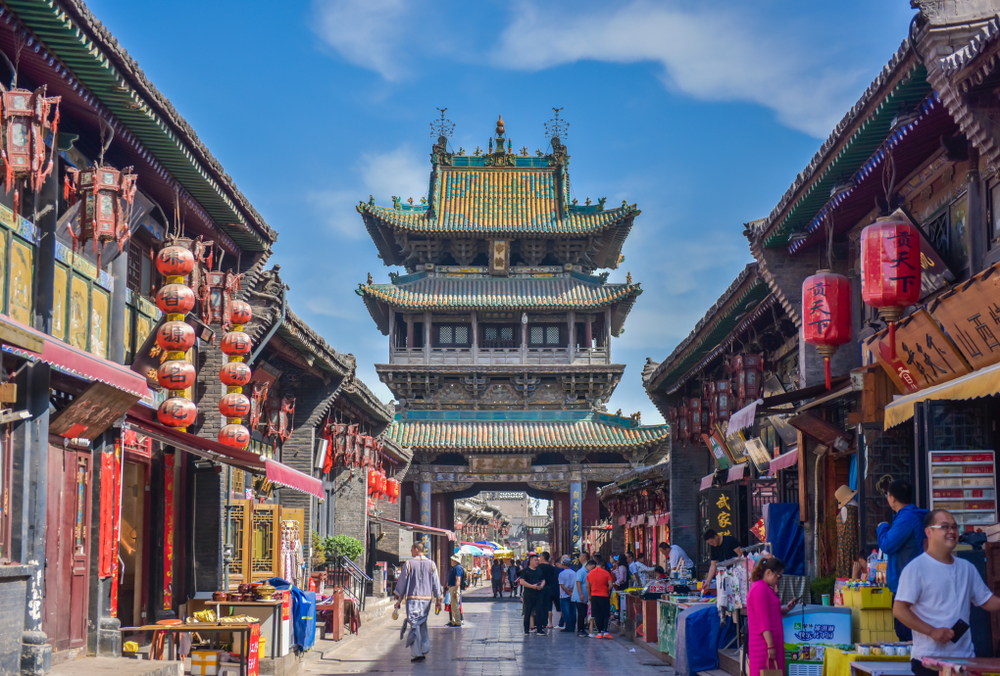
Pingyao Ancient City, Shanxi:
Pingyao Ancient City is one of China’s best-preserved ancient walled cities in China. What makes it even more fascinating is that it was one of the first cities in the world to use the concept of “draft banks” in the form of early banking houses during the Ming and Qing dynasties. This historical financial innovation allowed merchants to conduct business more securely, making Pingyao a hub for trade and finance in its time.
This UNESCO World Heritage site offers a peek into China’s fascinating history and culture.
How to Reach Pingyao Ancient City in Shanxi:
Nestled in central Shanxi Province, Pingyao is easily accessible via a short train ride from Taiyuan, the provincial capital.
Number of Days to Visit Pingyao Ancient City in Shanxi:
A 2-day trip will give you ample time to explore this historical gem.
Tourist Attractions and Things to Do in Pingyao Ancient City in Shanxi:
- Rishengchang Bank: The oldest bank in China, showcasing the financial ingenuity of the time.
- Pingyao City Walls: The walls offer panoramic views of the entire city.
- Temple of Confucius: A quiet space to contemplate and understand ancient philosophy.
- Ming and Qing Street: Walk along the streets to shop for souvenirs and taste local snacks.
- Ancient Government Office: Witness the architectural splendor and learn about historical governance.
Pingyao Ancient City is a vibrant museum of Chinese history waiting for you to step in and explore.
Ready to Explore Top Destinations in North America?

Victoria Harbour, Hong Kong:
Victoria Harbour, nestled among lush mountains, showcases Hong Kong’s iconic skyline and cultural treasures.
Victoria Harbour has a delightful tradition called the “Symphony of Lights.” This nightly multimedia light and sound show involves 44 key buildings on both sides of the harbor, creating a dazzling spectacle that has earned it a place in the Guinness World Records as the world’s “Largest Permanent Light and Sound Show.”
How to Reach Victoria Harbour in Hong Kong:
Nestled in the very heart of Hong Kong, Victoria Harbour separates Hong Kong Island from the Kowloon Peninsula. It is easily accessible by MTR, bus, or the famous Star Ferry.
How Much Time to Visit in Hong Kong:
Spend at least a day exploring the harbor and its surroundings. Take advantage of the Symphony of Lights, a nightly spectacle that lasts about 13 minutes.
Tourist Attractions and Things to Do in Victoria Harbour, Hong Kong:
- Symphony of Lights: A nightly multimedia show involving over 40 buildings on both sides of the harbor.
- Star Ferry Ride: An iconic way to traverse the harbor and soak in panoramic views.
- Sky100: A 360-degree indoor observation deck on the 100th floor of the International Commerce Centre.
- Harbour City Mall: Hong Kong’s largest shopping mall, offering more than 450 shops.
- Tsim Sha Tsui Promenade: The perfect spot for selfies with the skyline in the background.
For travelers captivated by skylines and modern marvels, Victoria Harbour is a not-to-be-missed experience. Between its daily hustle and breathtaking light shows, this is where Hong Kong’s heartbeat is most palpable.
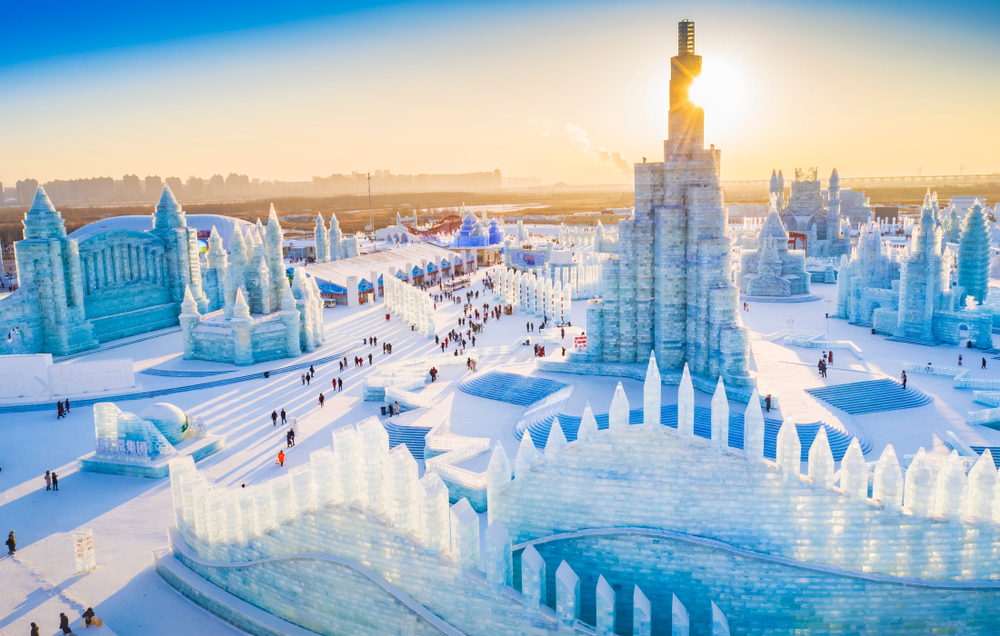
Harbin Ice and Snow Festival, Harbin:
The Harbin Ice and Snow Festival is a winter wonderland that showcases elaborate ice sculptures and structures. Journey into the frozen fantasy of Harbin, where the air shimmers with ice crystals, and the city becomes a playground of grand ice sculptures.
In winter, they source the ice for these creations from the nearby Songhua River. This annual festival attracts millions of visitors who marvel at the ephemeral artistry of these frozen masterpieces.
How to Reach Harbin Ice and Snow Festival:
Harbin, the capital of Heilongjiang Province, is located in northeast China. Reachable by plane, train, and long-distance bus, it’s a city that truly embraces its wintry reputation.
Number of Days to Visit Harbin Ice and Snow Festival:
To relish the artistry of ice and snow and experience all the activities, plan a visit lasting 3 to 5 days.
Tourist Attractions and Things to Do in Harbin Ice and Snow Festival:
- Ice and Snow World: A mammoth park featuring large, illuminated ice structures.
- Zhaolin Park: Home to the Ice Lantern Art Fair and smaller, detailed sculptures.
- Harbin Snow Sculpture Art Expo: A showcase of immense snow statues.
- St. Sophia Cathedral: A striking Russian Orthodox church.
- Central Street: A European-style avenue filled with boutiques, cafes, and local street food.
Whether you’re a winter sports fan or captivated by ice’s artistry, the Harbin Ice and Snow Festival is a feast for the senses. Dress warmly and come ready for a once-in-a-lifetime, frosty adventure.
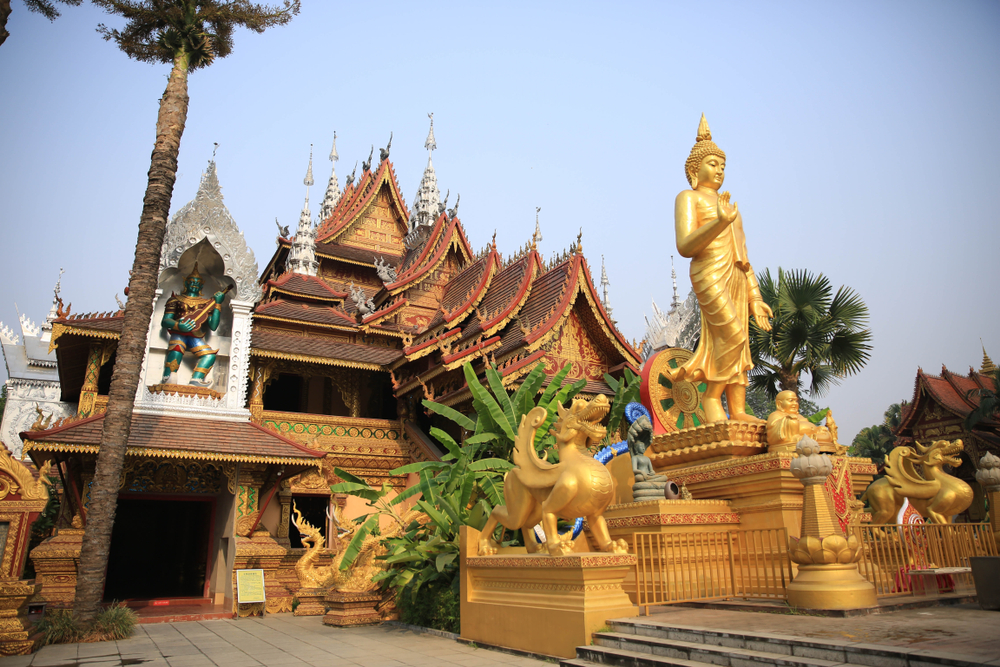
Xishuangbanna, Yunnan:
Xishuangbanna, located in the southernmost part of Yunnan Province, is known for its lush rainforests and diverse ethnic cultures. Picture endless rainforest stretches, exotic flora, and vibrant cultural tapestries that make this region an off-the-beaten-path wonder.
One fascinating aspect is its unique calendar, the “Dai Calendar.” This calendar does not follow the Gregorian calendar but is based on lunar months and agricultural activities, reflecting the connection between the local Dai people and their rural lifestyle.
How to Reach Xishuangbanna:
Nestled in the southernmost tip of Yunnan Province, Xishuangbanna shares borders with Laos and Myanmar. Accessible by flights from major Chinese cities or by bus from Kunming, the capital of Yunnan.
Number of Days to Visit Xishuangbanna:
A stay of 4 to 6 days allows ample time to explore the natural reserves, partake in local festivals, and delve into the unique Dai culture.
Tourist Attractions and Things to Do in Xishuangbanna:
- Xishuangbanna Tropical Botanical Garden: This Garden is one of the world’s largest botanical gardens, a must-visit for plant enthusiasts.
- Mengla Tropical Rainforest: A thrilling chance to explore one of China’s last remaining rainforests.
- Ganlanba: Also known as the “Olive Basin,” a low-lying area with Dai villages and water markets.
- Wild Elephant Valley: A sanctuary to observe wild Asian elephants.
- Jinghong: The region’s capital city, featuring a blend of modernity and traditional Dai culture.
Xishuangbanna’s blend of biodiversity and cultural richness, including the intriguing Dai Calendar, makes it an enchanting destination in China’s southwest, inviting travelers to explore its natural wonders and vibrant traditions.
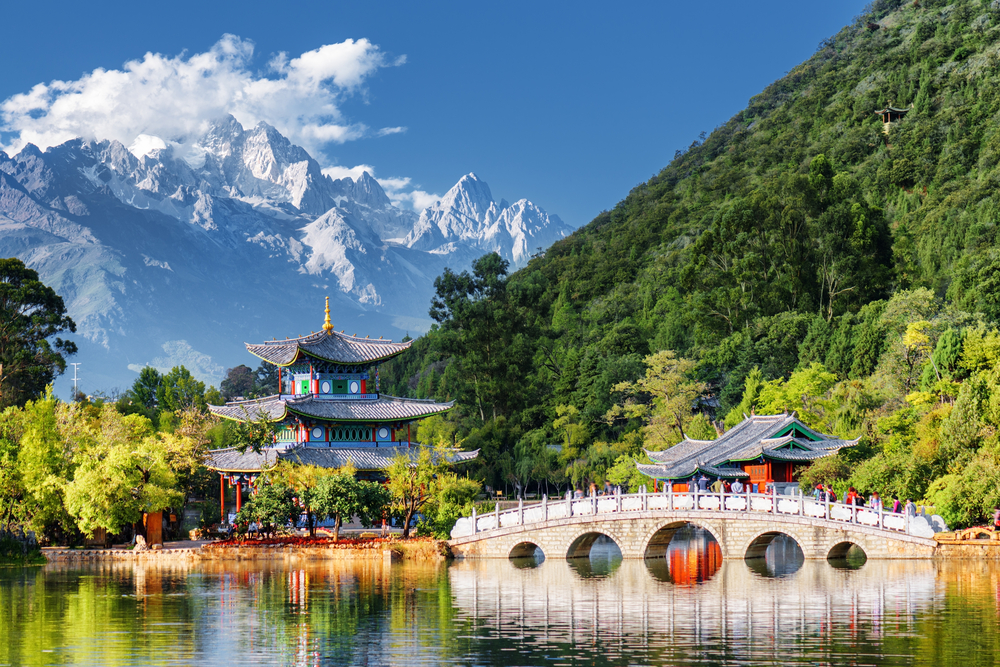
Jade Dragon Snow Mountain, Lijiang:
Jade Dragon Snow Mountain in Yunnan, China, is renowned for its 13 peaks, but the most exciting feature is the glacier at the mountain’s highest point, Shanzidou. Unlike any other destination in China, this alpine wonder invites you to swap the hustle and bustle of city life for the tranquility of high altitudes and sweeping vistas.
Surprisingly, the glacier is not only the southernmost glacier in the Northern Hemisphere but also one of the lowest-altitude glaciers in the world, making it a remarkable natural phenomenon worth exploring.
How to Reach Jade Dragon Snow Mountain in Yunnan:
The mountain is situated just 15 kilometers north of Lijiang in Yunnan Province. Direct buses and guided tours make it easily reachable for anyone looking to trade urban chaos for natural serenity.
Number of Days to Visit Jade Dragon Snow Mountain in Yunnan:
For an unforgettable journey, plan on 2 to 3 days. This will give you time for cable car rides, trekking, and absorbing the awe-inspiring scenery.
Tourist Attractions and Things to Do in Jade Dragon Snow Mountain, Yunnan:
- Ganhaizi Meadow: A high-altitude meadow providing panoramic views of the mountain.
- Impression Lijiang: A cultural show that tells the story of the native Naxi people against the mountainous backdrop.
- Blue Moon Valley: A picturesque valley with azure blue lakes.
- Spruce Meadow: A scenic spot accessible by cable car, ideal for photography.
- Baishui River: Originating from the glacier, this “White Water River” offers stunning vistas.
Jade Dragon Snow Mountain’s unique combination of towering peaks and the intriguing southernmost glacier offers a breathtaking and educational experience, making it an exceptional destination for nature enthusiasts and curious travelers.
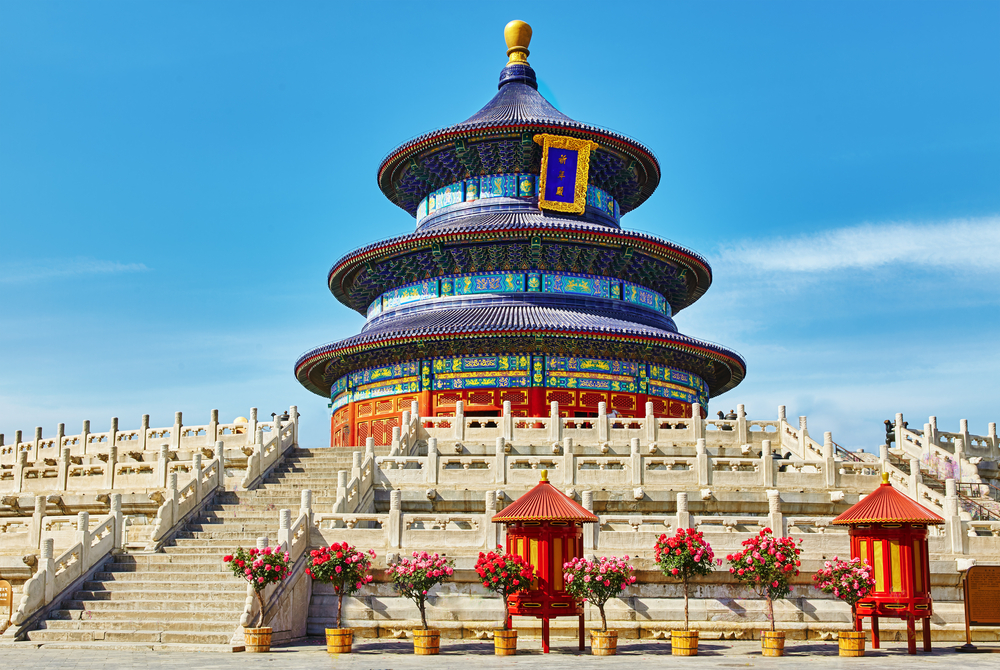
Temple of Heaven, Beijing:
The Temple of Heaven is an imperial complex in Beijing that offers a sacred escape and transcends mere architecture to become a spiritual sanctuary.
The Temple is an architectural marvel known for its precise design and acoustics. If you stand on a specific circular marble platform known as the “Echo Wall” and whisper, your voice can be heard clearly by someone standing on the opposite side, over 65 meters away. This acoustic wonder has fascinated visitors for centuries and showcases the incredible craftsmanship of ancient Chinese architects.
How to Reach The Temple of Heaven in Beijing:
The Temple of Heaven is situated in the southeastern part of central Beijing, easily accessible by subway or bus. In the midst of urban sprawl, it stands as an oasis of serenity and symbolic harmony.
Number of Days to Visit The Temple of Heaven in Beijing:
One day is typically sufficient to explore the complex and fully appreciate its historical and cultural nuances.
Tourist Attractions and Things to Do in The Temple of Heaven in Beijing:
- Circular Mound Altar: An outdoor altar with intricate designs symbolizing heaven and earth.
- Imperial Vault of Heaven: A single-gabled circular building surrounded by the Echo Wall.
- Hall of Prayer for Good Harvests: The iconic triple-gabled circular building symbolizes Beijing.
- Long Corridor: A beautifully decorated walkway that connects the main structures.
- Seventy-Year-Old Door: A special gate only used by the emperor, adding an element of imperial mystery.
For those looking to tap into the spiritual vein that runs through China’s rich history, the Temple of Heaven is an essential stop.
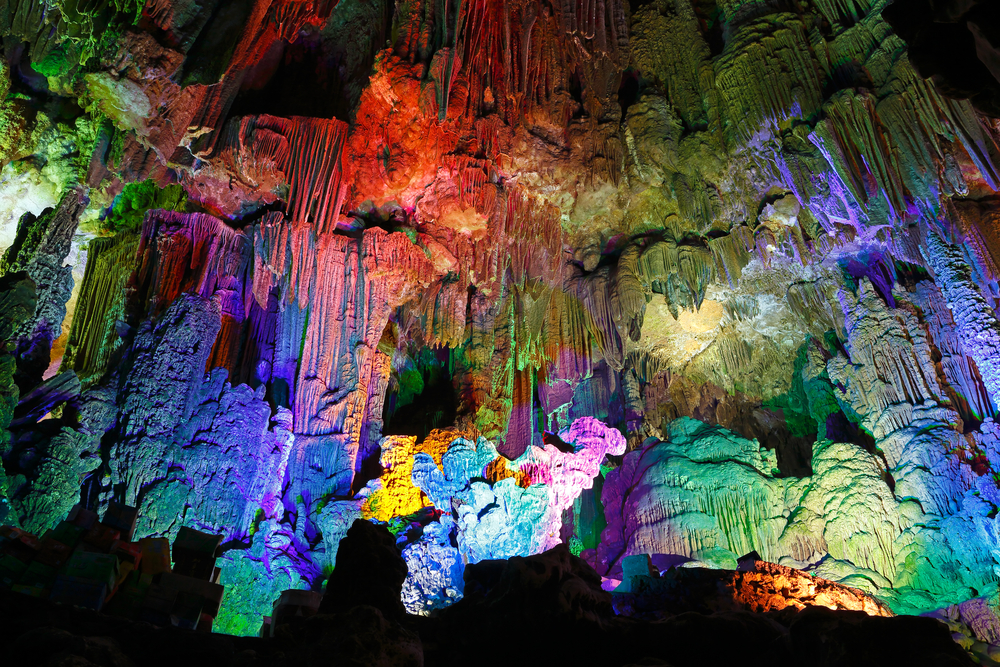
Reed Flute Cave, Guilin:
Reed Flute Cave in Guilin is a subterranean wonder that feels like walking through an ancient, otherworldly art gallery. This natural marvel is situated in Guilin and has been astonishing visitors for over 1,200 years.
Inside this limestone cave are over 70 inscriptions that date back over 1,000 years, revealing the historical significance of the cave as a canvas for poets and travelers to leave their mark. These inscriptions, illuminated by the cave’s colorful lighting, add to the enchantment of this underground world.
How to Reach Reed Flute Cave in Guilin:
Nestled just five kilometers northwest of downtown Guilin, the Reed Flute Cave is a must-see attraction, easily accessible by public transport or taxi.
How Much Time to Visit Reed Flute Cave in Guilin:
Allocate half a day to truly soak in the vibrant colors and stunning rock formations that decorate the cave’s interior.
Tourist Attractions and Things to Do in Reed Flute Cave, Guilin:
- Crystal Palace of the Dragon King: A chamber that could rival any fantasy setting.
- The Virgin Forests: Stone columns resembling trees create a forest-like ambiance.
- Flower and Fruit Mountain: Rock formations that astonishingly mimic natural flora.
- The Pines in the Snow: Stalactites that look like snow-covered pine branches.
- Sky-Scraping Twin: Two stalagmites that reach for the ceiling, symbolizing aspirations.
Reed Flute Cave is a profound reminder of nature’s uncanny ability to craft beauty in the most unexpected places. The play of light and shadow across the cave’s myriad formations offers a truly unforgettable visual feast.
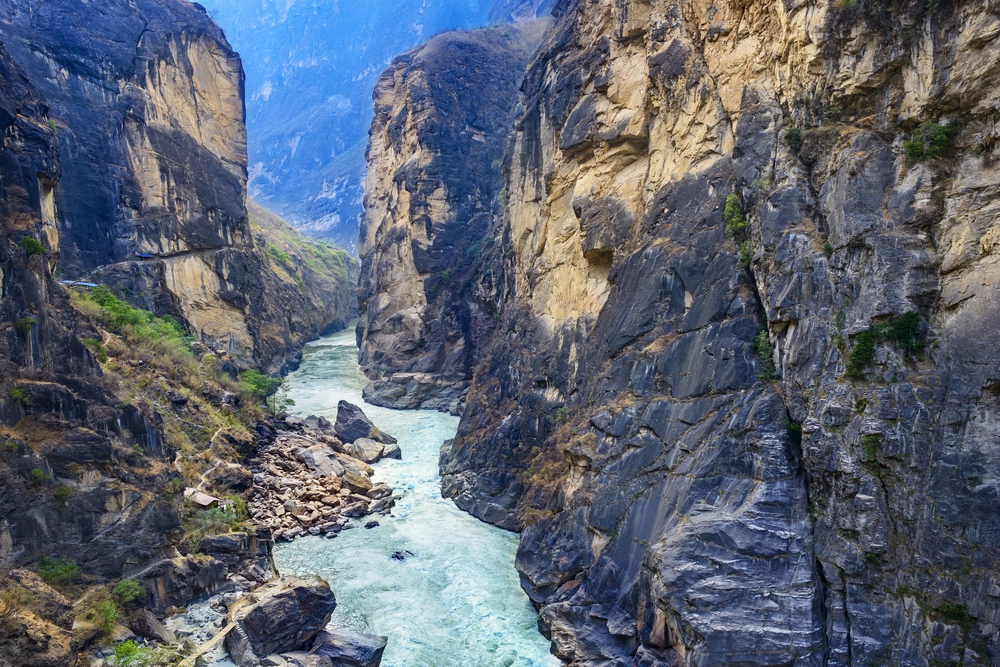
Tiger Leaping Gorge, Yunnan: A Hiker’s Paradise with Breathtaking Views
Tiger Leaping Gorge is one of the world’s deepest and most stunning river canyons. Set in the heart of Yunnan, it’s a paradise for outdoor enthusiasts.
The legend behind its name involves a tiger that supposedly leaped across the narrowest part of the gorge to escape a hunter. While the leap is quite challenging, the dramatic scenery and trekking opportunities here make it a must-visit for adventurous travelers.
How to Reach Tiger Leaping Gorge in Yunnan:
Located about 60 kilometers north of Lijiang, the gorge is carved by the mighty Jinsha River. It’s an ideal spot for those seeking an adrenaline-pumping adventure.
Number of Days to Visit Tiger Leaping Gorge in Yunnan:
For the complete experience, set aside 2 to 3 days for hiking, capturing panoramic photos, and absorbing the awe-inspiring views.
Tourist Attractions and Things to Do in Tiger Leaping Gorge, Yunnan:
- Upper Tiger Leaping Stone: A massive rock situated mid-river, said to be a leaping point for a mythical tiger.
- Middle Rapids: Perfect for photography and witnessing the power of the Jinsha River.
- Walnut Grove: A charming village that offers a peaceful stopover and incredible vistas.
- 28 Bends: A challenging but rewarding part of the hike, known for its zigzagging trail.
- Guesthouses: Scattered along the trail, they offer local cuisine and a chance to interact with locals.
Tiger Leaping Gorge’s dramatic natural beauty and legendary tales create an exhilarating destination for hikers and nature enthusiasts, offering a glimpse into nature’s marvels and local folklore in Yunnan.

